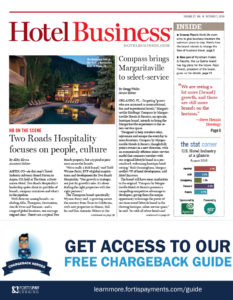 This year is shaping up to be a profitable year for hoteliers. According to industry reports, occupancy is up to 64.2% (up 0.8% year to date), ADR is around $128.57 (up 2.7%), and RevPAR is sitting at $82.57 (up 3.6%). Even better, projections for the remainder of 2018 expect that occupancy, ADR and RevPAR will remain on a steady climb. This is great news for hotel owners and operators, especially since we expect they will soon need to pay more for the goods being delivered to their properties due to the nationwide truck capacity shortage. The American Trucking Associations (ATA) estimates 51,000 more drivers are needed to meet demand, even though many transportation companies are giving double-digit raises. Government statistics cite the median pay for drivers at $42,000 per year— not enough, drivers say, to compensate for the “rough lifestyle.” What this ultimately means for the hospitality industry is more delivery delays and higher prices
This year is shaping up to be a profitable year for hoteliers. According to industry reports, occupancy is up to 64.2% (up 0.8% year to date), ADR is around $128.57 (up 2.7%), and RevPAR is sitting at $82.57 (up 3.6%). Even better, projections for the remainder of 2018 expect that occupancy, ADR and RevPAR will remain on a steady climb. This is great news for hotel owners and operators, especially since we expect they will soon need to pay more for the goods being delivered to their properties due to the nationwide truck capacity shortage. The American Trucking Associations (ATA) estimates 51,000 more drivers are needed to meet demand, even though many transportation companies are giving double-digit raises. Government statistics cite the median pay for drivers at $42,000 per year— not enough, drivers say, to compensate for the “rough lifestyle.” What this ultimately means for the hospitality industry is more delivery delays and higher prices
Three factors are contributing to the U.S. trucking shortage: 1) Fuel cost. After years of low oil prices, fuel costs have been increasing; 2) Low unemployment. As of March 2018, there are 6.6 million job openings in the U.S., therefore, it’s difficult to find people willing to drive trucks. Young Americans are ignoring the job openings because they fear self-driving trucks will soon dominate the industry. Although driving doesn’t require a college degree, it can be a hard lifestyle, and pay increases have lagged other industries; 3) New DOT regulations. A new federal safety rule issued by the Department of Transportation (DOT) in December is now requiring drivers to track their hours behind the wheel with electronic logging devices, or ELDs. This has exacerbated the problem, since previously some drivers didn’t keep accurate logs—more miles meant more pay. With ELDs now in place, some routes may now take two days instead of one because of stricter timekeeping. Consider this:
• Logistics and transportation accounts for about 10 cents of every dollar in the U.S. economy.
• 54 million tons of freight move across the U.S. every day.
• By 2040, the DOT anticipates the U.S. annual freight volume will increase by 45% to 29 billion tons (and most of that volume moves on the back of a truck).
• Approximately 71% of all freight tonnage in the country is moved by truck, which equates to more than 10 billion tons each year.
• To meet freight demands, 90,000 new-to-the industry drivers need to be hired every year for the next 10 years.
• The trucking industry needs to add almost 1 million new drivers by 2024 to keep up with demand, according to a recent ATA report.
Bracing for impact
The impact of this trucking shortage is amplified across the hospitality industry because the commercial drivers who service hotels are required to do a lot more than just transport goods from point A to point B. In many cases, drivers delivering wares and foodstuffs to a hotel are required to unload the freight and even put it away. It may require making multiple trips with a hand truck to stock freezers and storage rooms. Deliveries can arrive in the middle of the night or during a blizzard or torrential downpour. Then, factor in the new ELD equipment that ensures truckers don’t drive more than 11 hours a day and requires them to take specified breaks. Those willing to work long hours for bigger paychecks can no longer do so. It can be a lonely job at relatively low pay rates, and hoteliers and guests are beginning to feel the impact.
With too few drivers, some distributors are adjusting routes at the last minute or they are combining multiple routes. This changes the delivery window for hotels. When hotels don’t receive items on time for their restaurants and rooms, service suffers, and guests complain.
Since there seemingly is no short-term fix, every hotel—regardless of size, franchise affiliation and geography—should be considering the impact. The only way to solve this problem is to increase the rate of pay for truck drivers, but as that happens, hoteliers can bank on delivery prices increasing as well.
Procurement protection
There is good news. Priority shipping and delivery options are available for hotels with contractual protection on pricing. There also are ways for hotels to offset price increases, such as consolidating shipments. The larger the order, the better the price distributors will offer.
Freight increases are real; they will happen for the three reasons stated above. To get through this trucking shortage as smoothly as possible, hoteliers need to be vigilant and continually validate delivery prices.
Chip McIntyre is SVP, strategic sourcing for Avendra. McIntyre oversees Avendra’s contracting and supplier management functions, as well as the company’s Supply Chain Development team.
Let us know what you think… To comment on this opinion piece, or to voice your own opinion about pertinent industry topics, please email Editor-in-Chief Christina Trauthwein at [email protected]. We’d love to hear from you and share your point of view.

